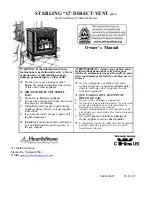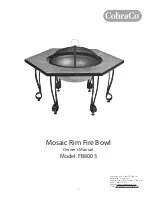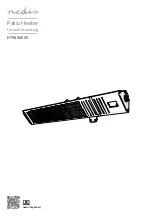
19
TABLE 5
Temperature
Time to Produce 2nd & 3rd
Setting
Degree Burns on Adult Skin
o
180°F (82°C)
Nearly instantaneous
170°F (77°C)
Nearly instantaneous
160°F (71°C)
About 1/2 second
150°F (65°C)
About 1-1/2 seconds
140°F (60°C)
Less than 5 seconds
130°F (54°C)
About 30 seconds
120°F (49°C)
More than 5 minutes
Valves for reducing point-of-use temperature by mixing cold and
hot water are available. Also available are inexpensive devices
that attach to faucets to limit hot water temperatures. Contact a
licensed plumber or the local plumbing authority.
The water temperature is controlled by a thermostat, fig. 1, which
has two sensing elements. One sensor is located near the top of
the tank and the other is near the center. The thermostat is set in
the lowest position before the heater leaves the factory.
The thermostat temperature dial, fig. 1, is accessible by removing
the control cover. The dial is adjustable and may be set for 120
0
(49°C) to 180
0
F (82°C) water temperature, but 120
0
F (49°C) is
the recommended starting point. It is suggested the dial be placed
on the lowest setting which produces an acceptable hot water
supply. This will always give the most energy efficient operation.
The temperature control has a 4
0
F fixed differential.
ADJUSTMENT PROCEDURE
1. Check gas line pressure and manifold pressure (table 6) and
adjust as required.
2. Check barometric damper for proper operation. Parts must
move freely.
3. Allow the unit to operate for 15 minutes. Draw hot water from
the heater or storage tank to continue main burner operation.
4. Determine heat input rate:
•
The input rate for natural gas models can be estimated
by timing the meter, if no other appliances are operating.
*With a stopwatch, or a wristwatch, which can display
the time in seconds, read the gas meter and measure
the amount of time required for the heater to consume 5
cubic feet of gas. The actual rate may then be estimated
by using the formula below:
Input Rate (Btuh) =
Actual Heating Value of Gas (Btu/ft
3
) x 18000
number of seconds to use 5 ft
3
of gas
The approximate heating value of natural gas is 1050 Btu/ft
3
.
Obtain the actual heating value of the gas at the site from the
gas utility. Propane (L.P.) gas has an approximate heating
value of 2500 Btu/ft
3
.
For example: Assume a ***81-270, firing on natural gas,
consumes 5 ft
3
of gas in 71.0 seconds.
The estimated input rate is:
(1050) x (18000) = 266000 Btuh
71.0
This is an acceptable input rate for a ***81-270, installed at
an altitude up to 2000 feet, as it is within 2% of the rated input.
For installations at higher altitudes, the input will be less for
the reasons explained in the FOREWORD.
•
The input may be adjusted by adjusting the pressure regulator.
Remove the top cap to expose the adjustment screw. Turning
the screw in increases the gas pressure and backing the screw
out decreases the pressure. Do not turn the adjusting screw
in past the point where no further increase in pressure is noted.
The manifold pressure is measured at the manifold pressure tap,
see Figure 7, and should be used as a reference point for making
pressure regulator adjustments. Table 6 gives the design manifold
pressures for each model. Increase or reduce the pressure as
required to obtain the rated input.
If an acceptable rate cannot be achieved by adjusting the pressure
regulator (manifold pressure), first check to be certain that the
gas supply pressure to the unit is adequate. If the supply pressure
is inadequate, a different burner orifice may be required. Obtain
from the utility the heating value and specific gravity of the gas at
the site. Provide this information and the altitude of the site to
the manufacturer to obtain a larger orifice size.
WARNING
UNDER NO CIRCUMSTANCES SHOULD THE INPUT RATE
EXCEED THE INPUT RATE SHOWN IN THE HEATER RATING
PLATE. OVERFIRING COULD RESULT IN DAMAGE OR
SOOTING OF THE HEATER.
5. Make combustion measurements and corresponding air shutter
adjustments per table 6. Combustion results from table 6 are
for natural gas models.
•
Proceed with CO
2
test of the flue gases with an Orsat or
other similar combustion test equipment. If the CO
2
content is within range (see table 6) no adjustment of
the air shutter is required. Flue gas temperature and
CO
2
measurements should be repeated 3 times to
ensure accurate readings.
•
Check the flue gas temperature ahead of the barometric
damper. See table 6 (net temp. = gross temp. = ambient
temp.)
•
Check breeching pressure and the barometric damper
control to make sure it operates freely and there is no
discharge of flue products into the room. See “Venting”
section.
TABLE 6
NOMINAL START-UP SPECIFICATIONS
***
***
***
***
MODEL
81-140
81-199
81-270
81-370
Max. Gas Line Press.(W.C.) Nat. Gas - 10.5”W.C./Prop. Gas - 13.0”
Manifold Press. (W.C.)
Natural Gas
3.5
3.5
3.5
3.5
Propane Gas
3.5
3.5
3.5
3.5
Orifice
Natural Gas
0.24
0.308
0.386
0.532
Propane Gas
0.209
0.257
0.302
0.368
Air Shutter Setting No.
Natural Gas
2.5
5.75
4
6.5
Propane Gas
4.5
10
4
8.5
CO
2
%
9.2%
9.8%
7.5%
8.0%
CO Parts Per Million
<200
<200
<200
<200
Gross Stack Temp. (°F)
305
338
468
540
Breeching Press.
(inches W.C.)
Ranges from - 0.30 to - 0.05 Inches Water Column










































